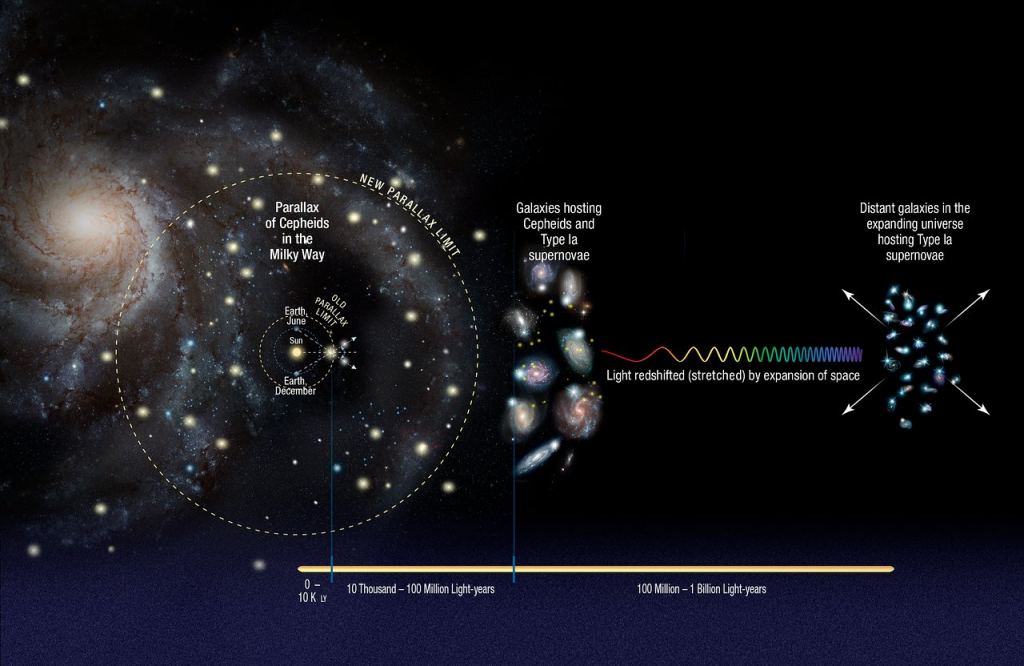Over a century ago, astronomers Edwin Hubble and Georges Lemaitre independently discovered that the Universe was expanding. Since then, scientists have attempted to measure the rate of expansion (known as the Hubble-Lemaitre Constant) to determine the origin, age, and ultimate fate of the Universe. This has proved very daunting, as ground-based telescopes yielded huge uncertainties, leading to age estimates of anywhere between 10 and 20 billion years! This disparity between these measurements, produced by different techniques, gave rise to what is known as the Hubble Tension.
It was hoped that the aptly named Hubble Space Telescope* (launched in 1990) would resolve this tension by providing the deepest views of the Universe to date. After 34 years of continuous service, Hubble has managed to shrink the level of uncertainty but not eliminate it. This led some in the scientific community to suggest (as an Occam's Razor solution) that Hubble 's measurements were incorrect. But according to the latest data from the James Webb Space Telescope* (JWST), Hubble's successor, it appears that the venerable space telescope's measurements were right all along.
The research was conducted by the Supernova H0 for the Equation of State of Dark Energy (SH0ES) project, an international effort to eliminate uncertainties in the Hubble-Lemaitre Constant. The team is led by Dr. Adam Guy Riess and consists of astrophysics from the Space Telescope Science Institute (STScI), John Hopkin's University (JHU), the NSF National Optical-Infrared Astronomy Research Laboratory (NOIRLab), Duke University, the École Polytechnique Fédérale de Lausanne (EPFL), and Raytheon Technologies. Their findings were published in the February 6th, 2024, issue of *The Astrophysical Journal Letters*.
The Hubble Tension arises from the fact that different distance measurements (aka. the " Cosmic Distance Ladder ") result in different values. For the calibration of short distances or the first "rung" on the ladder, astronomers rely on parallax measurements of nearby stars. For the next "rung," they rely on Cepheid variables and Type Ia supernovae to measure the distances to objects tens of millions of light-years away. Distance measurements for these stars by Hubble yielded a value of 252,000 km/h per megaparsec (Mpc).
The final rung consists of using redshift measurements of the Cosmic Microwave Background (CMB) to calibrate distances of billions of light-years. The mapping of this background by the ESA's Planck satellite yielded an estimate of about 244,000 km/h per Mpc (or about 269 km/s per light year). The simplest explanation for the discrepancy was that Hubble 's measurements were inaccurate, perhaps because of uncertainties in the Cosmic Distance Ladder. Since it was launched in December 2021, the JWST has made its own measurements of Cepheid variables with its advanced infrared optics.
This has allowed astronomers to cross-check the optical-light measurements made by Hubble. This includes Riess, the Bloomberg Distinguished and Thomas J. Barber Professor of Physics and Astronomy at John Hopkins University. In 2011, Riess was awarded the Nobel Prize in Physics and the Albert Einstein Medal for his co-discovery of the accelerating rate of cosmic expansion - which led to the theory of " Dark Energy." The team's first look at Webb's observations in 2023 confirmed that Hubble 's measurements of the expanding Universe were accurate.
Their latest analysis was based on Webb's observations of over 1,000 Cepheids used as "anchors" in the distance ladder, eight Type Ia supernovae, and NGC 5468 - the farthest galaxy where Cepheids have been well measured, roughly 130 million light-years distant. As Riess stated in an ESA press release, these findings have erased any lingering doubt about measurement errors:
"With measurement errors negated, what remains is the real and exciting possibility that we have misunderstood the Universe. We've now spanned the whole range of what Hubble observed, and we can rule out a measurement error as the cause of the Hubble Tension with very high confidence."
In particular, these findings have eliminated any lingering doubts that measurement inaccuracies might grow with distance. These inaccuracies would result from "stellar crowding," where light from the Cepheids blended with that of adjacent stars. For many astronomers, the prospect of looking deeper into the Universe meant that these errors would become visible. Accounting for this effect is made all the more difficult thanks to intervening dust in the interstellar and intergalactic medium (ISM, IGM) that naturally obscures visible light.
Thanks to Webb's sharp imaging capabilities at infrared wavelengths, astronomers can now see through the obscuring dust and get a clearer look at distant Cepheids. Combined with Hubble's observations, the SH0E team determined that Hubble 's observations were correct. As a result, said Riess, scientists are left with only one explanation for the Hubble Tension, which is that there is an unseen force responsible for how the cosmos is expanding:
"Combining Webb and Hubble gives us the best of both worlds. We find that the Hubble measurements remain reliable as we climb farther along the cosmic distance ladder. We need to find out if we are missing something on how to connect the beginning of the Universe and the present day."
Next-generation telescopes will investigate this mysterious unseen force in the coming years by measuring its influence on cosmic expansion. This includes NASA's upcoming Nancy Grace Roman Space Telescope* and the ESA's Euclid mission (which launched on July 1st, 2023). Paired with additional data obtained by Webb, these observations will allow astronomers to test " early Dark Energy " and other theories that attempt to explain the observations of Hubble and Webb*. In the meantime, the so-called " crisis in cosmology " will persist, but perhaps not for long.
*Further Reading: ESA*
 Universe Today
Universe Today

